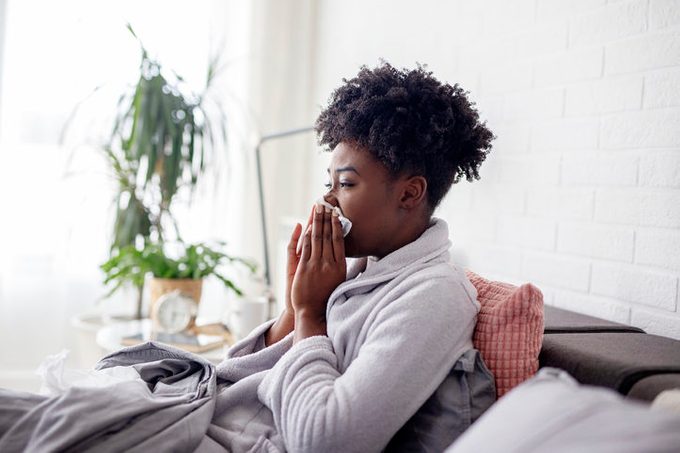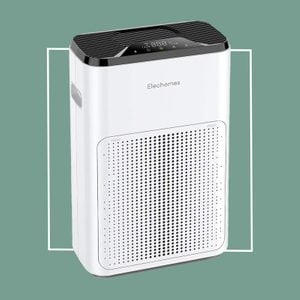If You Have Winter Allergies, Here’s Why and What Experts Recommend
Updated: Jun. 16, 2021
Seasonal allergies don't just happen in the spring and fall. Learn about the symptoms of winter allergies, as well as the causes and ways to prevent and treat them.
When allergy symptoms strike in the winter
You might think of winter as a time when allergies tamp down a bit, but it’s actually the prime season for allergic reactions to things like dust mites, mold, and pet dander, among others.
Yet winter doesn’t have to be the season of your discontent. There are ways to ease winter allergy symptoms and steps you can take to keep seasonal allergens from proliferating. Read on to find out what allergists recommend.
(Check out the weird things that happen to your body in winter.)
Allergies and allergens
Having an allergy means that you have an adverse reaction to a substance that is, for most people, harmless. “Allergies occur when a person’s immune system identifies a substance as a threat and creates an immune response to protect the body from the invader,” explains Sanjeev Jain, MD, PhD, an allergist, immunologist, and founder of Columbia Asthma & Allergy Clinics, which has locations in four states.
That allergy might be to food, such as nuts, dairy, or shellfish (just a few of the 9 most common food allergies), or to natural substances outside or inside the home.
“This can include pollen from trees, grasses, and weeds as well as animal dander, mold, and dust mites,” says Dr. Jain. The substance you’re allergic to is called an allergen.
An allergic reaction occurs when you inhale, eat, or are otherwise are exposed to an allergen. Your immune system springs into action to try to get the allergen out of your body. Your white blood cells produce antibodies called immunoglobulin E (IgE), which in turn triggers the release of chemicals called histamines.
Not everybody—or every body—produces these IgE antibodies to particular allergens, explains Payel Gupta, MD, an allergist and national spokesperson for the American Lung Association. But if you’re one of the 50 million people in the United States who have some type of allergic reaction, you have those IgE antibodies to thank.
Winter allergy symptoms
Histamines triggered by IgE antibodies target the affected parts of your body and try to force out the allergens. Sounds like a good system, right? Except that histamines cause allergy symptoms, which can include itching, increased secretions, and swelling throughout the body.
“When this occurs in the airway,” Dr. Jain says, “it can result in a cough, wheezing, mild shortness of breath, nasal congestion, and even a headache if the sinuses are affected. Postnasal drip can irritate the lining of your upper airway, causing a sore throat and a cough.”
Combined, these symptoms are referred to as allergic rhinitis. Some of these symptoms, especially congestion, often seem similar to cold symptoms. But a telltale sign of an allergic reaction is itchiness in the nose and throat.
Fever and body aches often accompany a cold but are rare with allergies. And unlike a cold, allergies don’t abate after several days. (Learn more about how to distinguish between a cold and allergy symptoms.)
Common winter allergens
Allergic rhinitis, when seasonal, usually flares in the spring and fall and is caused by tree and grass pollen. Those who suffer from perennial allergic rhinitis have allergy symptoms year-round. These perennial allergies are most often caused by indoor allergens, such as dust mites, mold, cockroach and mice droppings, and pet dander.
While these indoor allergens are usually present year-round, they may be more concentrated—or our reactions to them may be worse—in the wintertime.
“Many families keep their windows closed during winter months,” explains Dr. Jain. “This allows these allergens to accumulate within the home.” Central heat is another culprit, he says. “Without proper filtration, this forced airflow can keep some of these particles airborne throughout the day, increasing the chances of exposure to these allergens.”
Plus, he adds, the mucous membranes in our noses and eyes already tend to be irritated due to the cold, dry air. “So it does not take a very long exposure to an allergen to further exacerbate the irritation and cause allergy symptoms.”
And let’s not forget the pandemic. With many schools and offices closed as a result of Covid-19, Dr. Gupta adds, people and their pets are spending even more time indoors.
Some indoor allergens, like dust mites and pet dander (if you have pets), are always in our homes. We’re just more sensitive to them as we spend more hours indoors during the winter months. Others, like those caused by pests, may intensify in the winter. Cockroaches and mice are already used to searching for snacks in your home, but Dr. Jain says they may also take up residence in a hidden area of your home when it is cold and moist outside. To add insult to injury, their saliva, urine, and excrement contain a protein that’s a common allergen.
Cold temperatures may discourage mold growth in the home. But if you live in an area that experiences rainy winters, such as the southeast of the Pacific Northwest, that dampness may creep into your home and create a friendly environment for mold spores.

Identify allergens in the home
Some allergens are easy to see, while others are microscopic:
Dust mites
Even though they’re too small to see without a microscope, “everyone has dust mites in their home,” says Dr. Gupta. They feed on our dead skin cells, and if we’re allergic to them, she explains, it’s because we’re allergic to their droppings.
“They can live on bedding, mattresses, upholstered furniture, carpets, and curtains, where they feed on the flakes of skin shed by people and their pets,” adds Dr. Jain.
Cockroaches and mice
If there are cockroaches in your home, you might see them scurrying around your kitchen when you flip on the lights after dark or first thing in the morning. If you don’t see roaches but you suspect they’re in your house, look for their droppings, which appear as dark flecks, specks, or grains about the size of pepper or coffee grains.
Mice might be even harder to spot, but their droppings are larger—dark brown in color and shaped and sized like grains of rice. The droppings from either of these pests mean you have an infestation that needs to be dealt with, regardless of whether you have allergies.
Mold
Year-round, mold is likely to be present in areas of your house that are damp and don’t dry out sufficiently. It usually appears as a black, green, or even pink stain or pattern of growth on shower curtains, on bathroom tile grout, on window frames, and in rooms that are at least partially underground, like basements.
It can also appear around water or heating pipes that produce condensation, or where water has infiltrated into walls, floors, or cabinets and countertops. If you’ve had water damage in your home, mold growth is likely until proper mold abatement is done, Dr. Jain says. (Learn more about mold and other ways your house might be making your sick.)
Pets
If you’re allergic to dogs or cats but choose to keep them as pets anyway, your allergies might be worse in the winter, when all of you are closed up in the house together. “Pet dander is not easy to see but is present in every home with pets,” says Dr. Jain.
Diagnosing allergies
If you suspect you have allergies, there are two primary ways an allergist can verify. The first is an antigen-specific IgE test, a blood test that looks for specific antibodies in your blood that will react to specific allergens, including pollen, mold, dust mites, cockroaches, and pet dander. This is called sensitization.
“If you have a large number of antibodies developed against a particular substance,” explains Dr. Jain, “this indicates that your body has detected this antigen as foreign and built up a way to protect itself against the substance.” However, even if you are sensitized to an allergen and it shows up on a blood test, this doesn’t always translate into obvious symptoms.
The more common method of allergy diagnosis is via skin-prick testing. “A very small volume of the selected allergens will be placed on your skin by making a small indentation or ‘prick’ on the surface of your skin using a plastic device,” Dr. Jain explains. “If you have allergies, a little swelling that looks and feels like a mosquito bite will occur where the allergens to which you are allergic were placed.”
In even simpler terms, if your arm gets itchy and swollen at the point where dust mite allergen was introduced, you’re allergic to dust mites. “A major benefit of skin-prick testing is that have the results in 15 minutes,” says Dr. Gupta. “And you and your allergist get a clear idea of what you’re allergic to.”
Treating winter allergies
A go-to solution for treating winter allergies is one of the many over-the-counter (OTC) allergy products available without prescriptions. These include a wide range of oral antihistamines, like Zyrtec, Claritin, or Benadryl.
“Because allergic reactions produce histamines, antihistamines help to block this chemical from causing inflammation and irritation in our bodies,” says Dr. Gupta. She says that OTC steroid nasal sprays like Flonase and Rhinocort help with the inflammation caused by allergens in the nose.
(Check out these other allergy nasal spray brands that allergists recommend.)
A cautionary note on nasal sprays: Some of them are decongestants that can become habit forming if you use them too often, causing something called the rebound effect where you build up tolerance to the medication. Try not to use them for more than three days. For treating allergies, Dr. Gupta recommends avoiding nasal sprays that contain the decongestant oxymetazoline.
There are also OTC eye drops that contain an antihistamine that can help with itchy, watery eyes. “These are safe for regular use,” says Dr. Gupta. “But always check with your eye doctor if you have any underlying eye conditions.”
Your allergist can recommend other remedies, including prescription antihistamine nasal sprays or nasal steroid sprays that reduce inflammation. Dr. Gupta explains that for patients with severe and/or persistent allergic reactions, an allergist might suggest a course of immunotherapy—either in the form of shots in the office or sublingual (under the tongue) tablets that can be taken at home.
These work by introducing a controlled amount, gradually increased over time, of the known allergens into your body. “This can help reduce a person’s reaction to allergens over time and reduce the medications that are needed by desensitizing the body to the allergens to which you are allergic,” Dr. Gupta says. In effect, your body is trained not to see the allergen as a threat.
Dr. Jain also suggests that patients maintain a diet rich in vitamins C, D, and E, as well as zinc, fish oil, and fiber. “Research has shown that these nutritional supplements help to promote regular immune function,” he says.
Lastly, there is the neti pot—the at-home tool for rinsing nasal passages. “When you use a neti pot you are clearing the nasal passages of the allergens that cause the body to release histamines,” says Dr. Gupta. But remember to keep your neti pot really clean between uses. “If it is not kept clean,” she says, “it can develop mold, which is then put into the nasal and sinus cavities and can be very dangerous.”
Discourage allergen growth
The best way to beat winter allergies in the home is to discourage their growth in the first place. Solutions for doing this range from simple to more involved—and potentially costly.
Cleaning
A clean house is an unfriendly environment to lots of winter allergens. Vacuum carpets and hard floors once or twice a week with a vacuum cleaner equipped with a HEPA filter.
Try to keep household surfaces free of clutter, and dust surfaces regularly with a microfiber cloth that captures dust. “Dust that is visible to the human eye contains a mixture of the bodies of dead dust mites with mold, dander, and lint,” says Dr. Jain.
Keep your kitchen countertops and cooking areas clean, and make sure food is sealed in airtight containers that mice and roaches can’t wiggle their way into.
Mattress/pillow covers
There’s no way to eliminate dust mites, but you can create a barrier between them and you by investing in pillow and mattress protectors that dust mites can’t penetrate.
If you don’t want to spend the money on mattress protectors—they can get expensive—”at least get pillow covers,” says Dr. Gupta, “since that’s is where your face rests while sleeping.”
She also recommends washing bedding in hot water to kill dust mites and eradicate their droppings. One last piece of bedtime advice: If you have both pets and pet allergies, your bed—and the entire bedroom, really—should be off-limits to your furry friends.
Anti-allergen appliances
A number of vacuum cleaners and washing machines with steam technology are certified as asthma and allergy friendly by the Asthma and Allergy Foundation of America and the Allergy Standards Limited, meaning they’ve passed criteria that determine they’re helpful in either reducing or discouraging allergens in the home.
Air purifiers
An air purifier can filter out mold spores, pet dander, and other airborne allergens. Installing them in every room of the house can be pricey, but you should at least consider them in bedrooms. (Here are our picks for the best air purifiers.)
Get rid of carpet
If you really want to take steps to defeat winter home allergens, consider tearing out that wall-to-wall carpet and replacing it with asthma- and allergy-friendly hard flooring, where pet dander, dust mites, mold, and other allergens can’t hide.
Next, read about more ways that doctors allergy-proof their own homes.



